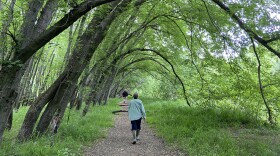Here’s a fun quiz to celebrate bird nesting season in New Hampshire. Listen to this episode and see how many bird nests you can identify, just by hearing a description!
Bird species choose different spots for their nests, and make the nests out of a variety of materials. But WHY they make these choices is complicated. There may be as many different reasons as there are different types of birds!
Nest materials vary with the plant materials available locally. But there are often particular sites or surfaces where you are likely to find nests: hollow live tree cavities, shrubbery, on the forest floor, on bare sand or gravel.

You may find them on rooftops, beneath peeling tree bark or tipped-up roots, inside chimneys and beneath eaves of barns and sheds. Some birds choose sheer cliff faces, like the peregrine falcon. In more urban environments, you'll find nests on tall buildings, bridges or communication towers.

Other birds nest exclusively over water and along shorelines. You will also find them in wetlands or in saltmarsh or sand dune habitats.
The top three priorities in real estate also apply to birds: location, location, location. The availability of a wider number of ideal nesting spots helps to avoid competition for a finite number of sites.
Birds choose the construction style and materials based on their lifestyle. Peripatetic cuckoos follow summer leaf-eating caterpillar population outbreaks. They don’t enjoy the luxury of time to build more elaborate nests or even feed and care for their own offspring.
Nest timing also reflects lifestyle. Early spring nesting birds tend to be seed-eating birds, like chickadees, titmouses, and nuthatches, gleaning overwintering insects while nesting inside relatively sturdy tree cavities.
Migrating songbirds that spend the winter in the tropics, like warblers, flycatchers, and vireos, time their late-spring arrivals to coincide with the abundance of insect protein that is not available until late spring.
The number of broods also impacts the kind of nest required. Some bird species raise just one or two chicks, and can build simple woven nests of plant fiber that may not survive winter winds and heavy snowfall. For example, the nests of mourning doves, who have 1-2 eggs, are flimsy and shallow, made of grass, twigs and pine needles.
Birds that raise multiple broods in a given year, such as phoebes, must build more sturdy nests. They may even get renovated in subsequent years.

Nest materials, locations, construction styles and timing have likely evolved to specific bird species’ circumstances, geographies and lifestyles.
Wild birds are generalists outside of the breeding season. But during the nesting season, they are very particular about where they nest…they might require specific locations, and even a particular height above the ground, or even below ground.
Something Wild is a joint production of New Hampshire Audubon, the Forest Society, and NHPR.











